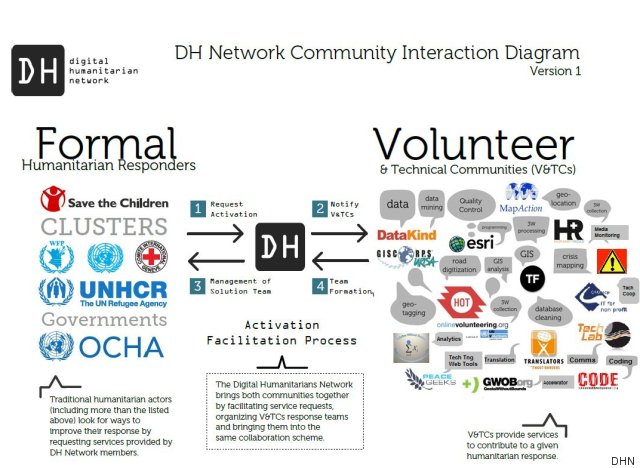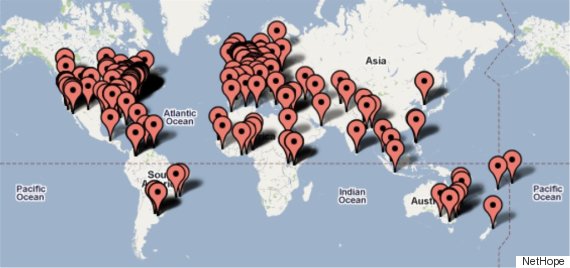When was the last time you heard news about the Ebola outbreak? In the past few months, the coverage has become less common as new infections being reported approaches zero. The fight isn't over, but as the situation continues to improve and experts have additional time to analyze the epidemic, a number of lessons learned are beginning to emerge. One in particular worth noting is the role of digital volunteers in countering crises.
In today's interconnected world, there is an unprecedented opportunity to make use of innovative technology to respond to humanitarian crises. Highly skilled technical workers are increasingly becoming a vital resource, volunteering their talents to assist with relief efforts. This trend if supported with additional training and resources could pave the way for increased efficiency in responding to global humanitarian crises.
One resource many humanitarian organizations turn to during a crisis is the Digital Humanitarian Network (DHN), a group of digital volunteers who expand response capacity during humanitarian crises such as the recent Nepal earthquake and Ebola outbreak in West Africa. DHN has volunteers ready to assist at a moment's notice. The network offers a variety of skill sets for supporting the work of humanitarian organizations. A few include mapping, data visualization, translation, and emergency telecommunication. DHN brings people together to respond to crises and helps alleviate potential backlogs of resources by streamlining the overall process and increasing the speed of response.

For many in the technology community, the DHN is a way to use of their unique skill set to help during a crisis. Most digital volunteers have full-time jobs and volunteer their free time. Much of their work is centered on small tasks, e.g. filling in spreadsheets with information or visualizing data to help on the ground responders. During the height of the Ebola crisis, the Standby Task Force assisted NetHope with searching for and identifying humanitarian organizations in different locations in Sierra Leone who needed assistance with internet connectivity. The digital volunteers collected publicly available organization names, location, latitudes and longitudes, and contact information.
In less than a week the digital volunteers identified over 200 locations in Sierra Leone. With the efforts of skilled NetHope team members this essential information was integrated and transformed into a detailed document which included a map and table for field staff to use. This digital volunteer work helped complement NetHope's initial assessments and led to new connectivity options for a few humanitarian organizations stationed in the field.
It can be challenging for digital volunteers to enter the humanitarian sector, however. It is filled with many unique challenges and has a fragmented structure. Needs, requests, and data sets frequently change dynamically over a short time span, and systems you'd often find in other sectors to deal with big challenges are not always in place because of the urgency to address crises at hand. Instead, the humanitarian sector often finds uncharted workarounds and focuses on moving forward with the best solution possible.
As an educator, I often find myself reaching for my educational and training hat, knowing it's what my volunteer colleagues need. During humanitarian crises however time is very limited. The overall goal is to execute deliverables in a safe and meaningful way to the best of your abilities. Of course, while abiding by humanitarian principles and for the service and support of those affected by the crisis. Often during a crises a stable setting can't be ensured, creating a steep learning curve.

Figure 1 Location of SBTF Members
Agility is a fundamental requirement for working in the humanitarian sector. The requirements don't end there, however. As the sector has learned the hard way, "good intentions" don't always equate to the best outcomes. There is a great need for a formalized system to better train people who are interested in digital volunteerism. Investment in onboarding digital volunteers with different types of skills and backgrounds is needed.
There is also a need to support and recognize that many digital volunteers need basic education about the humanitarian sector, specifically how it functions and the role of data and information management. At a minimum, these investments will help better prepare humanitarian organizations for future crises.
Moving forward, the humanitarian sector needs to help interested digital volunteers gain a deeper understanding of the sector to properly prepare them. After all, why should the sector sell highly skilled, motivated, and often extremely creative people short by not offering them the opportunity for basic humanitarian training. Thanks to modern technology there is an opportunity to upgrade the humanitarian sector with skilled technical resources but the infrastructure needs to be in place first however to ensure the connections work and information is being communicated optimally.
Special thanks to Roxanne Moore, Digital Humanitarian Network (DHN) Ebola Coordinator for helping with background information for the article.
NetHope is a partner of Cisco CSR. Cisco sponsors The Huffington Post's ImpactX section.